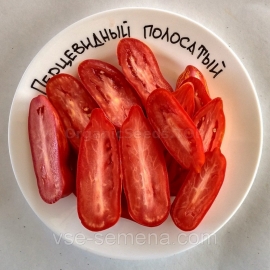


«Striped Red Pepper» - Organic Tomato Seeds
1.14 €
Mid early (103-110 days) variety for greenhouses and open ground. Plant height - 50-60 cm. Pepper fruits, with a sharp "nose", red with yellow stripes, very dense, fleshy, weighing 80-120 grams, with a high content of solids. Awesome!
-
Heirloom Tomato «Striped Red Pepper»
Mid early (103-110 days) variety for greenhouses and open ground. Plant height - 50-60 cm. Pepper fruits, with a sharp "nose", red with yellow stripes, very dense, fleshy, weighing 80-120 grams, with a high content of solids. Awesome!
Value varieties: the original color and shape of the fruit. It is recommended for the fresh use, conservation and processing on tomato products.
Detailed Striped Red Pepper Tomato Info:
- Type: Elonged
- Fruit color: Red, Striped
- Fruit Bearing: Determinate
- Days To Maturity: ~110 days
- Fruit Weight: ~4.2 ounces (~120 g)
- Spread: Mid
- Height: 20 inches (~50 cm)
- Sow Method: Indoor Sow
Planting Tips for Heirloom Tomatoes
Most gardeners want to get the most out of these delicious heirloom tomatoes and therefore give them a head start on the growing season. Start these vegetable seeds indoors in sterile potting mix being sure to keep the temperature above 70 degrees. Some people prefer to use a grow pad but the top of the fridge has been known to be quite effective as well.
Once the first true leaves appear on your tomato seedlings, transplant into 4" pots until you have completely hardened them off in the garden. Hardening is a process of exposing the plants more and more to outside temperature until they are hardy enough to tollerat a complete outdoor move. Generally speaking, by early summer heirloom tomatoes should be transplated into the garden.
Most heirloom varieties are quite productive and will greatly benefit from sturdy supports. It may also be advisable to add blood and bone to the worked soil to help ensure healthy productive heirloom tomatoes.
Seed Care tips for Heirloom Tomato Seeds
Heirloom seeds are hardy but always take care with your garden seeds to give them the appropriate amount of moisture - not letting the vegetable seeds dry out prematurely or overwatering and possibly having them rot.
